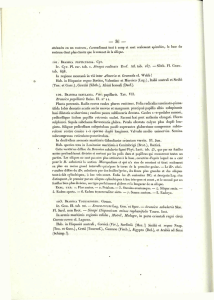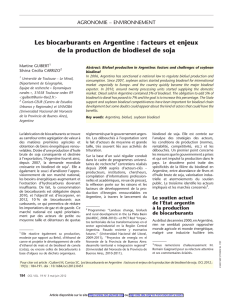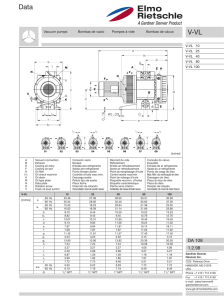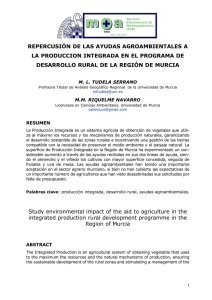“SINCRON”, A NEW Brassica carinata CULTIVAR FOR
Anuncio
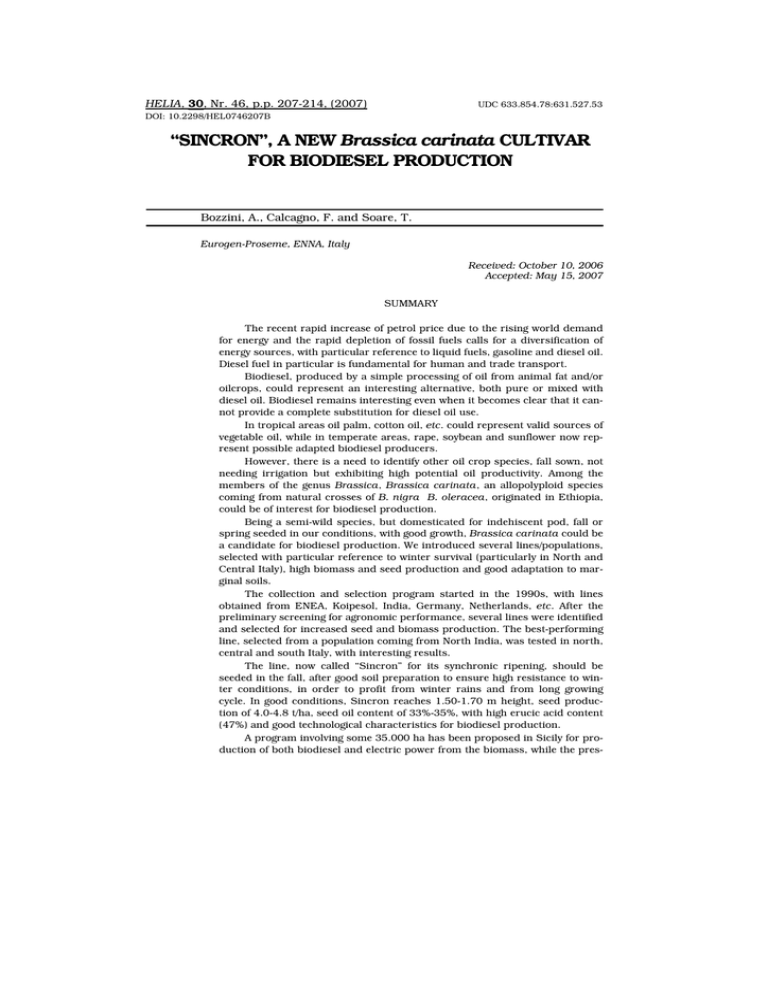
HELIA, 30, Nr. 46, p.p. 207-214, (2007) UDC 633.854.78:631.527.53 DOI: 10.2298/HEL0746207B “SINCRON”, A NEW Brassica carinata CULTIVAR FOR BIODIESEL PRODUCTION Bozzini, A., Calcagno, F. and Soare, T. Eurogen-Proseme, ENNA, Italy Received: October 10, 2006 Accepted: May 15, 2007 SUMMARY The recent rapid increase of petrol price due to the rising world demand for energy and the rapid depletion of fossil fuels calls for a diversification of energy sources, with particular reference to liquid fuels, gasoline and diesel oil. Diesel fuel in particular is fundamental for human and trade transport. Biodiesel, produced by a simple processing of oil from animal fat and/or oilcrops, could represent an interesting alternative, both pure or mixed with diesel oil. Biodiesel remains interesting even when it becomes clear that it cannot provide a complete substitution for diesel oil use. In tropical areas oil palm, cotton oil, etc. could represent valid sources of vegetable oil, while in temperate areas, rape, soybean and sunflower now represent possible adapted biodiesel producers. However, there is a need to identify other oil crop species, fall sown, not needing irrigation but exhibiting high potential oil productivity. Among the members of the genus Brassica, Brassica carinata, an allopolyploid species coming from natural crosses of B. nigra B. oleracea, originated in Ethiopia, could be of interest for biodiesel production. Being a semi-wild species, but domesticated for indehiscent pod, fall or spring seeded in our conditions, with good growth, Brassica carinata could be a candidate for biodiesel production. We introduced several lines/populations, selected with particular reference to winter survival (particularly in North and Central Italy), high biomass and seed production and good adaptation to marginal soils. The collection and selection program started in the 1990s, with lines obtained from ENEA, Koipesol, India, Germany, Netherlands, etc. After the preliminary screening for agronomic performance, several lines were identified and selected for increased seed and biomass production. The best-performing line, selected from a population coming from North India, was tested in north, central and south Italy, with interesting results. The line, now called “Sincron” for its synchronic ripening, should be seeded in the fall, after good soil preparation to ensure high resistance to winter conditions, in order to profit from winter rains and from long growing cycle. In good conditions, Sincron reaches 1.50-1.70 m height, seed production of 4.0-4.8 t/ha, seed oil content of 33%-35%, with high erucic acid content (47%) and good technological characteristics for biodiesel production. A program involving some 35.000 ha has been proposed in Sicily for production of both biodiesel and electric power from the biomass, while the pres- 208 HELIA, 30, Nr. 46, p.p. 207-214, (2007) ence of glucosinolates in the cake could be used for control of nematodes in greenhouses and protected cultivations, after the ban of methyl bromide. Key words: rapeseed, Brassica napus, cultivar Sincron, biodiesel, biomass INTRODUCTION In the recent period, petrol reached up to 78 US$ a barrel, with an official forecast of the Golden Sachs Bank of the possibility of reaching soon a price of 100 US$ a barrel. The increasing world demand for energy, with particular reference to the demand of several Asian developing countries and the rapid depletion of fossil oil natural reserves, are considered the main causes of this trend. According to experts of British Petroleum, we have already consumed 42% of all known fossil oil resources. A strong interest is felt at the global level for diversification of energy sources, in order to be able to better prepare for eventual future oil crises. To produce biodiesel, some tropical developing countries (Brazil, China, Indonesia, India, Vietnam, etc.) have recently planted several million hectares to oil palm, the highest oil-producing crop. Also, developed and developing countries in the temperate zone are planning to increase the production of adapted oilseed crops (soybean, sunflower, rapeseed, etc.) in order to contribute to energy production diversification. In Italy in 2002, 16 Mt (million metric tons) of gasoline, 26 Mt of gasoil and 1.3 Mt of GPL were used for vehicular transport; in 2004, the corresponding figures were 15 Mt of gasoline, 30 Mt of gasoil and 1.1 Mt of GPL. Biodiesel, either pure or mixed with gasoil, could contribute to reduced oil import and the export for cash, together with the increase of other national sources of energy production (bioethanol, biogas, solar, wind, geothermal energy, etc.). Moreover, the E.U. law 30/2003 assigns for Italy to use 800.000 t/year of biodiesel in the year 2010. In addition to the traditional oilcrops, there is a need to explore other sources of vegetable oil, to be used for biofuel production. Among the Brassicas and the related species, besides rapeseed (Brassica napus), there are several known oilproducing species (B. oleracea, B. juncea, B. nigra, B. carinata, Sinapis alba, etc.) to be analyzed and tested. Among these species, the rapeseed (Brassica napus) is best known and most extensively studied. High-yielding rapeseed cultivars with high content of erucic acid have been selected in Germany and other north European countries for biodiesel production. However, we identified also B. carinata as a possible interesting crop for biodiesel production. B. carinata is still a semi-wild, not fully known species, with seeds high in the erucic acid and glucosinolates and therefore not commonly used for production of edible oil. It originates from Ethiopia, where it had been derived as an allopolyploid from natural crosses of B. nigra × B. oleracea. Practically the only domestication HELIA, 30, Nr. 46, p.p. 207-214, (2007) 209 trait is a relatively delayed seed dehiscence, particularly if compared with the rapeseed. Moreover, we found lines with good tolerance to low temperatures and therefore with a possibility for fall seeding, particularly in central and south Italy. It also shows an increased tolerance to important parasites, Meligetes aeneus, Ceutorrhincus assimilis and some aphids. In the 1990s, several lines and populations were introduced in Italy, particularly through national and European projects financial support. However, at the time, the main interest was on edible oil and B. carinata exhibited some unacceptable traits (high content of erucic acid and glucosinolates). The collection and selection program started in the 1990s. Many populations and lines obtained from ENEA (Italy), Koipesol (Spain), India, Germany, Netherlands, etc. were grown in order to identify those more potentially productive and adapted to our conditions. Lines with low biomass, low height, high cold susceptibility, high dehiscence and low seed production were discarded after preliminary testing. The first agronomic trial was performed in the year 2000. It included 7 best performing selected lines. It was followed by trials conducted in south, central and north Italy, in which B. carinata was compared against some of the most diffused cultivars of rapeseed. The best seed production line in the trials, derived from a population coming from North India, was named “Sincron”, because of a good synchronization of ripening, another important character for mechanical harvesting. MATERIAL AND METHODS The original material (35 entries) was grown in single rows of 10 m, 50 cm between rows, at the rate of 10 kg of seed/ha. Seven best performing lines/populations were grown in 3 replication plots of 12 m2, after seeding in December 1999 in Enna (Sicily). Based on the results obtained, a line was selected and grown in the following years in large plots in south Italy (Sicily), central Italy (Viterbo) and north Italy (Filo di Ferrara, Ancona) with fall and spring seeding. The best performing line was named Sincron, in relation to the exhibited ripening synchrony. 210 HELIA, 30, Nr. 46, p.p. 207-214, (2007) EXPERIMENTAL RESULTS First agronomic results were obtained in Gelsi locality (Enna Province, Sicily, 1999-2000) (Table 1). Table 1: Agronomic trial with the 7 selected lines Seed production (t/ha) Lines No. Maturity day/month 1st 2nd 3rd Mean 1 20 VI 4.2 4.0 4.5 4.23*** 2 15 VI 3.8 4.0 3.8 3.87*** 3 18 VI 2.8 3.1 2.6 2.83--- 4 10 VI 2.6 2.8 2.5 2.63--- 5 7 VI 2.9 2.9 2.1 2.63--- 6 7 VI 1.9 2.2 2.1 2.07*** 7 12 VI 2.0 1.9 2.0 1.97*** Mean 13 VI 2.89 (***) Significant difference 0.1% Two lines were distinguished for high production at 0.1% significance level. Analyses for oil seed content gave 35% for line 1 and 33% for line 2. The fatty acid analysis (performed by INRAN) of the 2 best performing lines gave the following composition data: Table 2: Fatty acids composition of the 2 best lines Fatty acids Line No. 1 Line No. 2 Palmitic acid 6.7 8.5 Linoleic acid 18.2 25.4 Oleic acid 11.0 12.1 Stearic acid 5.4 3.6 Gadolic acid 7.5 6.0 Erucic acid 47.0 34.7 Line No. 1 (Sincron) was grown in Viterbo (central Italy) in 2003-2004 at 2000 m2, seeded on 15 December at the rate of 10 kg/ha and, when combine harvested, it gave a yield corresponding to 4.4 t/ha. In 2004, Line No. 1 was seeded at the rate of 20 kg/ha, on 3 April, at 0.63 ha, in a hilly area close to Senigallia (Ancona, central Italy), without irrigation. The vegetation cycle lasted only 100 days. The crop was combine harvested and gave a yield corresponding to 1.0 t/ha of seed yield. It should be noted that normally, the production life cycle of B. carinata should be of some 250 days. In 2003-2004, Line No. 1 was grown also in Filo of Alfonsine (Ferrara) in an agronomic trial, seeded in the fall (15 October 2003) and in spring (3 March 2004) at the rate of 10 kg/ha. The results of the subsequent analyses are presented in Table 3. Late seeding affected not only seed production but also seed oil content. HELIA, 30, Nr. 46, p.p. 207-214, (2007) 211 In 2005-2006, Sincron was tested in 2 agronomic trials, with 5 replications at 10 m2 in Enna Province (Sicily) in Gelsi and Geracello localities, in comparison with 3 cvs of rapeseed (B. napus): “Comet”, “Dubla” and “Sponsor”. In Gelsi, the material was seeded in mid December, while in Geracello at the end of January. Table 3: Seeding date effect on some important production parameters of Brassica carinata cv. “Sincron” No. Analyzed parameter 1. Seeding time Fall 2003 Spring 2004 Moisture (%) 6.3 6.7 2. Ashes (%) 5.1 4.8 3. Proteins (%) 29.4 33.8 4. Non protein substances (%) 15.3 16.2 5. Fibres (%) 8.1 8.6 6. Lipids (%) 35.8 29.9 7. Seed Production (t/ha) 3.7 2.2 8. Oil Production (kg/ha) 1.315 658 9. Biomass production (t/ha) 24.6 17.3 10. Life cycle (days) 241 128 The mean production of Sincron in Gelsi was 2.5 t/ha, of Comet 1.2, of Dubla 1.5 and of Sponsor 1.8 t/ha; in Geracello, Sincron produced 4.3 t/ha, Comet 2.0 t/ ha, Dubla 2.3 t/ha and Sponsor 2.8 t/ha. In both trials the Sincron production was significantly higher at 0.01% level. CONCLUSIONS From the results obtained in trials and cultivation in the last 7 years, the cv Sincron consistently had a higher production than the other tested B. carinata and B. napus lines, populations or cvs. If seeded at proper time (possibly in October in north Italy and in November in central and south Italy), the seed yield has been around or over 4 t/ha. With an oil content of seeds of at least 33-35%, the oil production should be over 1 t/ha. In normal conditions the cv Sincron has a vigorous growth, even on marginal soils, the vegetation height reaches 1.60-1.70 m; the stem and leaves are deep green, with anthocyanin in cold periods; leaves are waxy; flowers are white, pods are yellow and seeds are brown. Pods are more resistant to shattering than rape cvs, providing more time and easier and more complete mechanical harvesting. The selection of Sincron will continue, to explore the variability for seed oil content and eventually isolate higher oil content plants. The selection is easy, since the species is largely self pollinated. A program of selection for low glucosinolates of another B. carinata line, after irradiation of seeds, has been performed by ENEA (Brunori, personal communica- 212 HELIA, 30, Nr. 46, p.p. 207-214, (2007) tion) without clear results, probably because of the allopolyploid nature of this species. A program involving some 35,000 ha has been proposed in Sicily for production of both biodiesel and electric power from the biomass of Sincron. It should be noted that the high content of glucosinolates in the cake could be used for control of nematodes in greenhouses and protected cultivations in general, after the ban of methyl bromide (Lazzari, personal communication). “SINCRON”, LA NUEVA VARIEDAD DE BRASSICA CARINATA PARA LA PRODUCCIÓN DE BIODIESEL RESUMEN El reciente incremento rápido del precio de petróleo debido a la demanda global incrementada de energía y el rápido consumo de los combustibles fósiles impide que se diversifiquen las fuentes energéticas, sobre todo los combustibles líquidos, como petróleo y diesel. Sobre todo, el combustible diesel representa la base para el transporte de la gente y de las mercancías. Biodiesel producido por simple producción de aceite de las grasas animales o vegetales, podría ser una alternativa interesante, como combustible puro, o mezclado con diesel del petróleo. Biodiesel permanece interesante hasta cuando queda claro cuando el mismo no puede ser pleno sustituto para diesel del petróleo. En las regiones tropicales, el aceite de palma, aceite de algodón, etc. Pueden ser fuentes de aceite vegetal aceptables. En las regiones moderadas, la colza, soya y girasol actualmente representan las fuentes de biodiesel posiblemente ajustadas. Pero, se presenta la necesidad de encontrar otros cultivos oleaginosos, que se siembren en otoño, que no requieran irrigación, y que tengan alto potencial para la producción de aceite. Entre los miembros del género Brassica, Brassica carinata, la especie alopoliploide del cruzamiento anterior de B. nigra × B. oleracea, podría ser de interés para la producción de biodiesel. Teniendo en cuenta que se trata de una especie semisalvaje, regulada gracias a la vaina indehiscente, que en nuestras condiciones se siembra en otoño y primavera, Brassica carinata podría ser candidato para la producción de biodiesel. Nosotros hemos investigado varias líneas/poblaciones, seleccionadas especialmente por su habilidad de sobrevivir el invierno (especialmente en Italia septentrional y central), alta producción de biomasa y semilla y buena adaptación a los terrenos marginales. El programa de recolección y selección, empezó en los años 90 del siglo pasado, con las líneas obtenidas de las Compañías ENEA y Koipesol, y de la India, Alemania, Holanda, etc. Tras las investigaciones preliminares de las características agronómicas, fueron elegidas varias líneas debido a la incrementada producción de la semilla y biomasa. La línea con las mejores propiedades, seleccionada de la población de La India septentrional, fue investigada en Italia septentrional, central y meridional, con interesantes resultados. Esta línea, llamada “Sincron” debido a su maduración uniforme, debe sembrarse en otoño, tras una buena preparación de presiembra, que garantiza HELIA, 30, Nr. 46, p.p. 207-214, (2007) 213 buena resistencia a las condiciones invernales, para aprovechar las caídas invernales y largo ciclo vegetativo. En buenas condiciones, Sincron logra la altura de 1.50-1.70 m, una producción de semilla de 4.0-4.8 toneladas/ha, contenido de aceite en la semilla de 33%-35%, con alto contenido de ácido erúcico (47%) y buenas características tecnológicas para la producción de biodiesel. El programa que abarque unas 35.000 ha, fue propuesto para Sicilia, para la producción de biodiesel y energía eléctrica de la biomasa. La presencia de glucosinolato en el biscocho, podría utilizarse para la represión de nematodas en invernaderos y otros espacios protegidos, tras la prohibición de metilbromida. “SINCRON” UN NOUVEAU CULTIVAR DE BRASSICA CARINATA POUR LA PRODUCTION DE BIODIESEL RÉSUMÉ La récente augmentation du prix du pétrole due à une demande d’énergie plus grande dans le monde et la consommation rapide des carburants fossiles exigent la diversification des ressources énergétiques, surtout du carburant liquide comme l’essence et le diesel. Le carburant diesel surtout est essentiel au transport des personnes et des marchandises. Le biodiesel produit par simple transformation d’huile obtenue de gras animal ou végétal pourrait être une alternative intéressante autant comme carburant pur que comme carburant mêlé à de l’huile diesel. Le biodiesel demeure intéressant même s’il est clair qu’il ne peut pas être totalement remplacé par le diesel provenant du pétrole. Dans les régions tropicales, l’huile de palme, de coton etc. pourraient être des sources acceptables d’huile végétale. Dans les régions tempérées, le colza, le soja et le tournesol représentent actuellement des sources possibles de biodiesel. Cependant, il est nécessaire de trouver d’autres cultures oléagineuses. Celles-ci seraient semées à l’automne, elles n’exigeraient pas d’irrigation et elles auraient un grand potentiel de production d’huile. Parmi les membres du genre Brassica, Brassica carinata, une espèce allopolyploïde issue de croisements naturels de B. nigra x B. oleracea, originaire d’Éthiopie pourrait être intéressante pour la production de biodiesel. Comme il s’agit d’une plante à demi sauvage, domestiquée pour sa cosse indéhiscente, semée à l’automne et au printemps dans nos conditions, Brassica carinata pourrait servir à la production de biodiesel. Nous avons introduit plusieurs lignées/populations, sélectionnées avec une attention particulière pour la survie hivernale (particulièrement dans l’Italie du nord et du centre), une grande production de biomasse et de graines ainsi qu’une bonne adaptabilité aux sols marginaux. Le programme de cueillette et de sélection a commencé dans les années 90 du siècle dernier avec des lignées obtenues des firmes ENEA et Koipesol, d’Inde, d’Allemagne, de Hollande, etc. Après les examens préliminaires des caractéristiques agronomiques, plusieurs lignées ont été choisies pour une production augmentée de graines et de biomasse. La lignée avec les meilleures performances, sélectionnée de populations d’Inde du Nord, a été testée en Italie du nord, du centre et du sud et les résultats obtenus ont été intéressants. La lignée, maintenant appelée “Sincron” à cause de sa maturation synchronique, doit être semée à l’automne après une bonne préparation du sol 214 HELIA, 30, Nr. 46, p.p. 207-214, (2007) pour que lui soit assurée une grande résistance aux conditions hivernales et de façon à ce qu’elle profite des pluies hivernales et d’un long cycle de croissance. Dans de bonnes conditions, Sincron arrive à une hauteur de 1,50–1,70 m, une production de graines de 4,0-4,8 t/ha, un contenu d’huile dans la graine de 33%-35%, avec un contenu élevé d’acide érucique (47%) et de bonnes caractéristiques technologiques pour la production de biodiesel. Un programme qui comprendrait quelques 35 000 ha a été proposé à la Sicile pour la production aussi bien de biodiesel que d’énergie électrique à partir de la biomasse. La présence de glucosinolates dans le tourteau pourrait être utilisé pour l’élimination de nématodes dans les serres et les espaces de culture protégés après l’interdiction touchant le bromure de méthyle.
